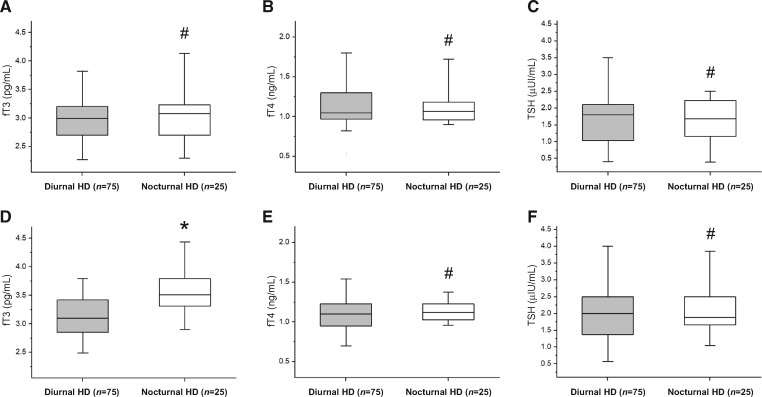FIGURE 5.
Thyroidal status between diurnal and nocturnal HD patients assessed at baseline and during an 8-year follow-up. At baseline, patients treated with diurnal HD showed a thyroidal status comparable with patients treated with nocturnal HD (LNHD) [2.98 ± 0.45 pg/mL versus 3.11 ± 0.52 pg/mL, P = 0.280 for fT3 (A); 1.11 ± 0.29 ng/mL versus 1.18 ± 0.39 ng/mL, P = 0.136 for fT4 (B); 1.74 ± 0.92 µIU/mL versus 1.59 ± 0.97 µIU/mL, P = 0.307 for TSH (C)]. During an 8-year follow-up, patients treated with diurnal HD showed lower mean fT3 serum levels as compared with those treated with nocturnal HD (LNHD) (D) (3.14 ± 0.38 pg/mL versus 3.56 ± 0.50 pg/mL, P < 0.001). No differences in mean fT4 and TSH levels were observed between diurnal versus nocturnal patients in the same period (E and F) (1.07 ± 0.24 ng/mL versus 1.15 ± 0.16 ng/mL, P = 0.150 for fT4; 2.16 ± 0.95 µIU/mL versus 2.00 ± 0.89 µIU/mL, P = 0.462 for TSH). Mann–Whitney U-test for non-parametric data. Data in the graphs are expressed as median and 25th and 75th percentiles in boxes and 5th and 95th percentiles as whiskers. #P = Not significant (NS); *P < 0.001. Patients treated with nocturnal HD (LNHD): white box; patients treated with diurnal HD: grey box.

